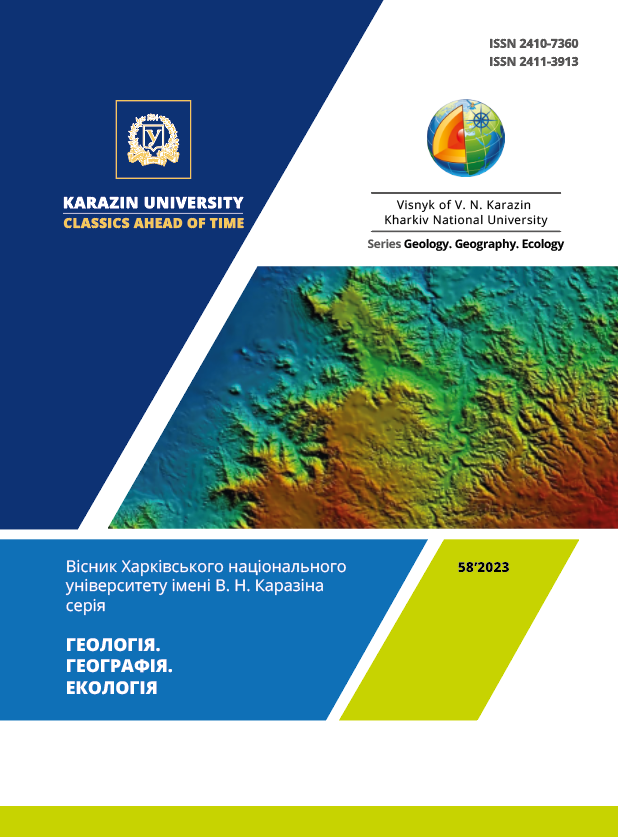До питання виокремлення урбаністичних геоситуацій
Анотація
Автори подають новітнє поняття урбаністичної геоситуації (УГСит), під якою можна розуміти динамічний аспект існування різних конфігурацій урбаністичного середовища (УС). Вказане поняття подається в рамках концепції урбогеоситем (УГС). УС, у свою чергу, є моделлю реально існуючого (фізичного) міського довкілля. Підкреслюється значення міських мешканців у трансформації статичної урбаністичної конфігурації у геоситуацію. Зазначається ефективність використання даних дистанційного лазерного сканування (лідарні дані) і переходу від двовимірного до тривимірного міського кадастру для виокремлення УГСит. Викладається предметний контент урбаністичної геоситуації і пояснюється її структурна успадкованість при розростанні міст. На прикладі забудов міст Вашингтон та Харків пояснюються особливості формування геоситуацій та їх вплив на міський розвиток. Виникаючі геоситуації в міському середовищі є повторюваними і формують різнорангові патерни геоситуацій. Виокремлення таких патернів впроваджується на підставі ГІС-функціональності візуального аналізу архітектурної морфології міста. Наводиться приклад дослідження патернів геоситуацій за допомогою структурованих наборів лідарних даних. Пояснюється динамічна мінливість геоситуацій в контексті щоденної концентрації населення в міському середовищі при зміщенні його центрів тяжіння. Підкреслюється, що УГСит формують структурні інваріанти УГС і можуть бути представлені у якості дискретних ГІС-сутностей. Авторами пропонується веб-ГІС, яка надає інструменти для виокремлення та аналізу УГСит на підставі лідарних даних. Наводяться також користувацькі сценарії, які можуть бути розраховані в даній веб-ГІС за обраними геоситуаціями, а саме: аналіз видимості, оцінка енергоспоживання будівель та оцінка чисельності населення по архітектурній морфології міста.
Завантаження
Посилання
Bartie P. Reitsma F. [and other]. (2010). Advancing visibility modelling algorithms for urban environments. Com-puters, Environment and Urban Systems. 34, 518-531. DOI: https://doi.org/10.1016/j.compenvurbsys.2010.06.002
Benedikt M.L. (1979). To take hold of space: isovists and isovist fields. Environment and Planning B. 6, 47-65. DOI: https://doi.org/10.1068/b060047
Cheer, B.C. (2017). Urban morphology as a research method. Planning Knowledge and Research: NewYork, NY, USA. 167-181, DOI: http://dx.doi.org/10.4324/9781315308715-11
Czyńska, K. (2015). Application of Lidar Data and 3D-City Models in Visual Impact Simulations of Tall Buildings. Int. Arch. Photogramm. Remote Sens. Spatial Inf. Sci. XL-7/W3, 1359-1366, DOI: https://doi.org/10.5194/isprsarchives-XL-7-W3-1359-2015
De Floriani, L., Magillo P. (1999). Intervisibility on terrains. Geographic Information Systems: Principles, Tech-niques, Management and Applications. John Wiley & Sons, 543-556
Jiang, B., Claramunt, C. (2005). Integration of space syntax into GIS: new perspectives for urban morphology. Transactions in GIS. 6(3), 295-309, DOI: https://doi.org/10.1111/1467-9671.00112
Kostrikov S., Pudlo R., Bubnov D., Vasiliev V. (2020). ELiT, multifunctional web-software for feature extraction from 3D LiDAR point clouds. ISPRS International Journal of Geo-Information. 9(11), 650-885, DOI: http://dx.doi.org/10.3390/ijgi9110650
Kostrikov, S., Niemets, L., Sehida, K. [and other]. (2018) Geoinformation approach to the urban geographic sys-tem research (case studies of Kharkiv region). Visnyk of V.N. Karazin Kharkiv National University. Series “Geolo-gy. Geography. Ecology”, 49, 107-121. DOI: https://doi.org/10.26565/2410-7360-2018-49-09
Kostrikov, S., Pudlo, R., Kostrikova, A. [and other]. (2019). Studying of urban features by the multifunctional ap-proach to LiDAR data processing. IEEE Xplore Digital Library. Electronic ISSN: 2642-9535, DOI: http://dx.doi.org/10.1109/JURSE.2019.8809063
Kostrikov S, Bubnov D, Pudlo R. (2020). Urban environment 3D studies by automated feature extraction from Li-DAR point clouds. Visnyk of V. N. Karazin Kharkiv National University, series “Geology. Geography. Ecology”, 52, 156-182. DOI: https://doi.org/10.26565/2410-7360-2020-52-12
Kostrikov S., Seryogin D. (2022). Urbogeosystemic Approach to Agglomeration Study within the Urban Remote Sensing Frameworks. Urban Agglomeration: INTECH Open. 1-23, DOI: http://dx.doi.org/10.5772/intechopen.102482
Natapov A. Czamanski D., Fisher-Gewirtzman D. (2013). Can visibility predict location? Visibility graph of food and drink facilities in the city. Survey Review, 45, 462-471, DOI: https://doi.org/10.1179/1752270613Y.0000000057
Rana S, Batty M. (2004). Visualising the structure of architectural open spaces based on shape analysis. Interna-tional Journal of Architectural Computing, 18, 1123-1132, DOI: https://doi.org/10.1260/1478077041220241
Rubtsov V.A. Gabdrakhmanov N.K., Mustafin M.R. [and other]. (2015). Field theory in Geography and stable structure of geoformations. Mediterranean Journal of Social Sciences, 6(3), 673-677, DOI: https://doi.org/10.5901/mjss.2015.v6n3p673
Samoilenko V., Dibrova I. (2019). Geoecological situation in land use. Journal of Environmental Research, Engi-neering and Management, 75(2), 36-46, DOI: https://doi.org/10.5755/j01.erem.75.2.22253
Stephen S., Li W., Hahmann T. (2022). Geo-Situation for Modeling Causality of Geo-Events in Knowledge Graphs. arXiv preprint arXiv:2206.13658, DOI: https://doi.org/10.48550/arXiv.2206.13658
Tobler W.R. (1965). Computation of the correspondence of geographical patterns. Papers of the Regional Science Association, 15, 131-139, DOI: https://doi.org/10.1007/BF01947869
Trofimov A., Pianova O. (1997). Social-Economucal Situation Analysis. 10th Europ. Colloq. of Theoretical and Quantitative Geography. Rostock, Germany. Inst. of Regional Geography, Leipzig, 86-88
Zvolinski A. (2014). A day in a shadow of high-rise: 3D parameterization and use of public space around pżm / hotel radisson building complex in center of Szczecin. Architecture et Artibus, 1, 67-71
Bezruk V.A., Kostrikov S.V., Chuiev O.S. (2016). Optimizing allocation of catering institution establishments through the urbogeosystem GIS-analysis (case study of Kharkiv). Human Geography Journal, 21(2), 91-101 [in Ukrainian]
Kostrikov S., Serohin D., Berezhnoy V. (2021). Visibility analysis of the urbanistic environmet as a constituent of the urbogeosystems approach. Human Geography Journal, 30(1), 7-23, DOI: https://doi.org/10.26565/2076-1333-2021-30-01 [in Ukrainian]
Kostrikov S.V., Serohin D.S., Kravchenko K.O. (2022). Workshop on creating GIS maps, spatial analysis and geo-processing on full-format GIS platforms (using the example of ArcGIS 10.2 and QGIS 3.16): Educational and methodological manual for university students. Kharkiv, 499 [in Ukrainian]
Serohin D.S. (2019). Analysis of urbogeosystemic properties of the spatial and geographic extent of Washington through GIS-modeling based on LiDAR data processing: master's thesis. Kharkiv, 105 [in Ukrainian]
Serohin D.S. (2021). GIS-modeling and 3D-visualization of the city buildings in the Mapbox web-GIS environment. Region 2021: Human–Geographical aspects. Proceedings of the International Conference for young scientists and post–graduate students. Kharkiv, 157-159 [in Ukrainian]
Chuiev O.S., Kostrikov S.V. (2015). City well-being spatial differentiation as the urbogeosystem function assess-ment with GIS-tools (case study of Kharkiv). Human Geography Journal, 18(1), 52-62, DOI: https://doi.org/10.26565/2076-1333-2015-18-09 [in Ukrainian]

Цю роботу ліцензовано за Міжнародня ліцензія Creative Commons Attribution 4.0.





